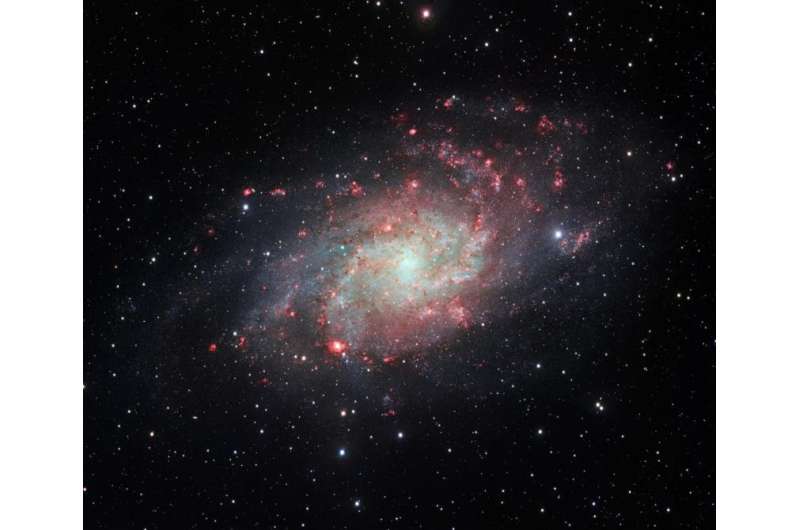FADO—a ground-breaking tool to reconstruct the history of galaxies

FADO is a new analysis tool developed by Instituto de Astrofísica e Ciências do Espaço (IA) astronomers Jean Michel Gomes and Polychronis Papaderos, which uses light emitted by both stars and ionized gas in a galaxy to reconstruct its formation history by means of genetic algorithms. This tool was presented in a recent article, accepted for publication in the journal Astronomy & Astrophysics.
"Fado" derives from the Latin "Fatum," which means fate or destiny, and it's a tribute to Portugal's immaterial cultural heritage type of music of the same name. Each galaxy has a fado—a narrative of its biography since the birth of its first stars. This fate is written in its electromagnetic spectrum, which contains the fossil records of multiple stellar populations that formed over several billion years, as well as the gas that those stars ionize with their radiation.
Deciphering the star formation history of a galaxy from its spectrum is one of the most challenging tasks in astronomy. An innovative and distinctive feature of FADO is the use of genetic algorithms, which simulates galaxy evolution like the evolution of a living organism. It works by "breeding" multiple genetic threads for a galaxy, each defined by a set of parameters (similar to the genetic code in DNA), which evolve through exchange of "chromosomes," mutations and selection effects, until a population that matches the observed stars and gas emission of the galaxy is reached.
Jean Michel Gomes (IA & University of Porto) says, "FADO is the first spectral modeling code employing genetic differential evolution optimization in combination with artificial intelligence algorithms. This results in key improvements in computational efficiency and accuracy to which the star formation history of galaxies can be reconstructed."
Previous computer models developed for this purpose suffer from severe uncertainties, partly because they take into account only the light from stars. However, the contribution from ionized gas can add up to 50 percent of all emitted light in a galaxy.
Researcher Polychronis Papaderos says, "FADO is the first code of its type that simultaneously models stellar and ionized gas emissions in galaxies. It also integrates physical prescriptions which ensure that the star formation history computed for a galaxy consistently reproduces its observed ionized gas emission. This presently unique self-consistency concept, in conjunction with the innovative mathematical foundation of FADO will allow us to gain new sharp insights into the galaxy formation history."
FADO's unique physical and mathematical concept yields great gain in computational efficiency, making the exploration of the star formation history of millions of galaxies an affordable task.
FADO will be an essential analysis tool to use with new generation instruments like MOONS, to be installed in the VLT (ESO). "MOONS is being constructed under the co-coordination of IA, and includes a substantial scientific and technical contribution from the Portuguese team. FADO will enhance tremendously our capability of exploiting the state-of-the-art observations MOONS will do from 2019 onwards," states the coordinator of IA, José Afonso.
More information: J.M. Gomes et al. Fitting Analysis using Differential evolution Optimization (FADO): Spectral population synthesis through genetic optimization under self-consistency boundary conditions, Astronomy & Astrophysics (2017). DOI: 10.1051/0004-6361/201628986
Journal information: Astronomy & Astrophysics
Provided by Instituto de Astrofisica e Ciencias do Espaco





















